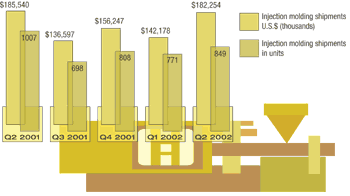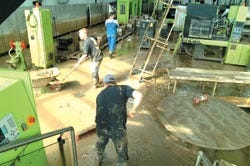September 25, 2002
|
While the gains remain minimal, new machinery and equipment sales data released by the Society of the Plastics Industry’s Committee on Equipment Statistics show upward trends for the first two quarters of 2002 in units and dollar value of injection molding machines shipped. |
Machinery statistics offer optimism
In line with many leading economic indicators, the plastics machinery and equipment sector continues to show some gradual increases, reflecting a warmer, if only tepid, plastics processing spending environment. Displaying minimal gains and softening declines, the Society of the Plastics Industry’s (SPI) latest report from its Committee on Equipment Statistics (CES) released data from the second quarter of 2002 that offer a positive, albeit muddled, outlook.
Overall, from June 2001 through June of this year, manufacturers or importers of plastics machinery and equipment in the U.S. shipped $983 million worth of product. Combined data of the dollar value of shipments for injection, blowmolding, and auxiliary equipment actually displayed a 3.6 percent increase in Q2 2002 from the second quarter of last year. New orders in dollars surged 18.9 percent in the second quarter compared to the same period last year.
In the injection molding sector, although year-on-year data reflect continued market skittishness, shipments over the last four quarters are trending up. From Q3 2001 through Q2 2002, 3126 injection molding machines were shipped, valued at $617.3 million. Overall, however, in a comparison of Q2 2001 to Q2 2002, molding machines in units fell 15.7 percent, and their dollar value dipped 1.8 percent. Yet shipments of injection molding machines have shown a cumulative increase over the last four quarters. Total units from Q3 2001 through Q2 2002 posted marks of 698, 808, 771, and 849.
There is some indication of processors’ willingness to reinvest in their plants, and this guarded optimism was most evident in the auxiliary equipment statistics. For the last four quarters, Q3 2001 to Q2 2002, auxiliary shipments totaled $274 million, with the dollar value of the shipments rising 9.9 percent from Q2 2001 to Q2 2002.
Automakers post record sales, but have suppliers profited?
In the wake of the Sept. 11 attacks, automotive manufacturers attempted to keep American consumers’ engines from stalling by extending discounts and financing deals on new cars and trucks. Nearly a year later, with many discounts or variations of them still in place, the automotive OEMs’ effort continues to pay dividends, according to a report in The Detroit Free Press. For August, carmakers posted sales of 1.7 million vehicles, a 13.2 percent increase over the 1.45 million sold for the same month last year, and the most cars sold in any month this year. The sales surge was felt most strongly by the Big Three automakers, which were the first to initiate sales incentives immediately after the attacks. They enjoyed a 15 percent increase over a year ago, which nearly doubled what foreign-based manufacturers posted as a group.
The record month has analysts optimistic that auto manufacturers will be able to reach the benchmark of 17 million vehicles for 2002 and potentially make the final tally the fourth-best year in history.
Individually, DaimlerChrysler showed the most dramatic increase, watching its sales surge 23.6 percent, thanks in large part to a record month for its Jeep brand. GM’s sales rose 18.2 percent, prompting the automaker to raise its third quarter and full-year profit forecasts. Ford’s sales increased the least, 8.2 percent, but its top-selling model, the Explorer, enjoyed its best month ever with 51,021 models sold—an industry-record month for any SUV.
These strong sales have put a sizable dent in automotive inventories, which bodes well for automotive molders. One such example is GM’s stable of 2002 models, which currently stands at 300,000—down one-third from the same time period last year.
Foreign automakers were not left out of the buying bonanza. Toyota, Honda, and Nissan, which all operate domestic plants, posted increases of 13.2, 12.9, and 19.8 percent respectively. Korean automaker Hyundai, which recently opened an assembly plant in Alabama, sold 40,266 cars in August, for its 19th consecutive month of record sales.
Presumably these superb sales would trickle down to the molders who supply automotive manufacturers with a sizable amount of parts and components, but a new study suggests otherwise. The Automotive Consulting Group Inc. (ACG), an Ann Arbor, MI-based management consulting firm, asserts that automotive suppliers’ profits have crashed over the last two years. According to ACG’s report, median automotive suppliers watched their profitability free-fall 54.4 percent, from 6.4 percent in 2000 all the way down to 2.9 percent in 2001.
The study, involving 43 publicly traded automotive suppliers headquartered in the U.S., looks at all levels of suppliers, including manufacturers of components, subsystems, and even entire assemblies.
The study also found that some suppliers, defined in the study as high performers, actually increased their margins by more than 75 percent, thanks in large part to their ability to manage costs. Looking at costs of goods sold (COGS) vs. OEM price reduction demands, the study found that high performers cut COGS year-over-year from 74 percent in 1992 to 66.6 percent in 2001. The median group of suppliers watched their COGS rise from 77.6 to 79.2 percent, while low-performing suppliers suffered increases from 79.7 to 85.9 percent.
Hiro Mori, ACG’s lead analyst on the study, says the consequences are obvious for the low-performing suppliers’ ever-rising costs of goods in times where automotive manufacturers continue to squeeze the entire supply chain with steep price reductions.
“The study is an indicator of things to come,†Mori explains. “Each year that we do the study, we find that several low performers from the previous year are either bankrupt or no longer in business.â€
Engel endures flooding
When torrential rains swept through Austria on Aug. 8 and 12, machinery maker Engel watched waters engulf its main manufacturing plant in Schwertberg. Located in northern Austria, Engel’s Schwertberg plant was completely inundated by floodwaters from the Danube River, which destroyed much of the company’s manufacturing infrastructure, but spared its employees, who were on the company’s annual two-week holiday.
|
Hit twice by floods in August, machine manufacturer Engel continues efforts to bring its Schwertberg, Austria plant online. These photos show the destruction and cleanup immediately after the flood. |
Despite the best efforts of local firemen, the Red Cross, the Austrian army, and Engel’s own employees to clean up the plant and salvage what they could, Peter Neumann, a spokesman for Engel’s board of management, says it’s difficult to accurately determine when the facility will once again be fully functional. But he thinks that when it comes online once again, it will be even better than before.
“We cannot yet calculate the entire extent of the damage,†Neumann said in a statement, “but we shall not only repair the damage straight away, but also make this natural catastrophe an opportunity to rebuild and re-equip Engel for the future.â€
Indeed, dubbing its reconstruction effort the Engel Phoenix Project, the Austrian machine manufacturer hopes its plant can, like the mythical bird, rise from the ashes or, in this case, floodwaters. The company set aggressive goals to restart production but admitted delivery delays of eight to 10 weeks were to be expected. Engel had hoped, however, that its replacement parts center would be operational by the beginning of September, with its machine assembly process online by the middle of the month followed by full operations by the end of 2002.
At its peak, the Schwertberg facility manufactured 2400 injection molding machines annually.
New Canadian custom molder acquires plant
Hoping to tap into the consumer and medical products markets via a new, custom facility, a single undisclosed investor has acquired RenWel Inc., a custom molder located in Goderich, ON. Borrowing the town’s name, the new facility will be called Goderich Plastics Inc. and employ 20 people held over from RenWel, although plans are in place to increase staff to 50 as soon as possible.
Currently the 86,400-sq-ft plant operates nine presses ranging in size from 150 to 600 tons and features a centralized material handling system originating from four silos, as well as centralized compressed-air and chilling systems. Land and plant size will allow for an eventual doubling of the facility.
Trepidation regarding any new investment is to be expected, but Goderich VP of sales and marketing Mike Lang admits that given the tumultuous state of the U.S. economy and its symbiotic relationship with Canada, there is an added level of anxiety, initially.
“To be honest,†Lang admits, “the two economies are the traditional tail and the dog. No tail has out-survived a sick dog, so the two economies are really linked. An awful lot of what we ship to our customers ends up subsequently being decorated and ends up back in the U.S. as a consumer item. So if the consumers in the U.S. aren’t buying, our customer’s not decorating, and we’re not molding. It’s a very tight little circle.â€
Short shots
Gearing up for the fast-approaching National Plastics Exhibition, the Society of the Plastics Industry (SPI, Washington DC), announced that the official show website, www.npe.org, now accepts preregistration for the June 23-27, 2003 show. The cost of onsite registration for NPE is $75, but preregistration costs are $25 from now through December, and $50 after that. In addition to registration, the NPE site features a list of exhibitors, a show video, a virtual tour, links to Chicago-related sites, and SPI contact information. The site also has plans for a housing selector to allow visitors to choose, confirm, and pay deposits on hotels.
After receiving an affirmative vote from 22 moldmaking shops throughout Ohio, the American Mold Builders Assn. (AMBA) announced the formation of a new chapter in northern Ohio, making it the 12th AMBA chapter nationwide. The Chicago-based trade association now has 411 member companies representing approximately 9000 U.S. moldmaking employees.
Danaher Corp. (Cleveland, OH) has entered into an agreement to purchase Thomson Industries Inc. (Port Washington, NY), combining that company’s linear motion control products with its own to create Danaher Linear Motion Systems. Through the sale of actuators, linear bearings and shafting, ballscrews, linear guides, gearheads, and other motion systems, Thomson generated 2001 revenues of $173 million. The purchase price was $165 million.
Described as the world’s first pilot plant to create high-temperature membrane electrode assemblies (MEAs) used in fuel cells, Celanese AG (Kronberg, Germany) opened a new facility in Kronberg dedicated to the development of that portion of fuel cell technology. Celanese describes MEAs, where hydrogen and oxygen react to generate electricity and heat, as the heart of fuel cells’ polymer electrolyte membranes. With potential applications ranging from powering a mobile phone to running a car or power plant, Celanese is banking on continued growth and subsequent demand in the fuel cell market.
The Minco Group (Dayton, OH), representing All Service Plastic Molding Inc. and Minco Tool & Mold Inc., has announced a $1.5 million investment for additional capacity. The company purchased two new presses, a 720-ton machine from Mitsubishi and a 950-ton machine from Toshiba, as well as an additional 12,000 sq ft of production space. Minco believes the additional production capabilities will help generate 30 new jobs.
Adding 30,000 sq ft for future capacity and to improve material flow now, Vesta Inc. (Franklin, WI) has completed an expansion to help it serve the medical device market. Liquid, transfer, and insert molding were also added.
You May Also Like





